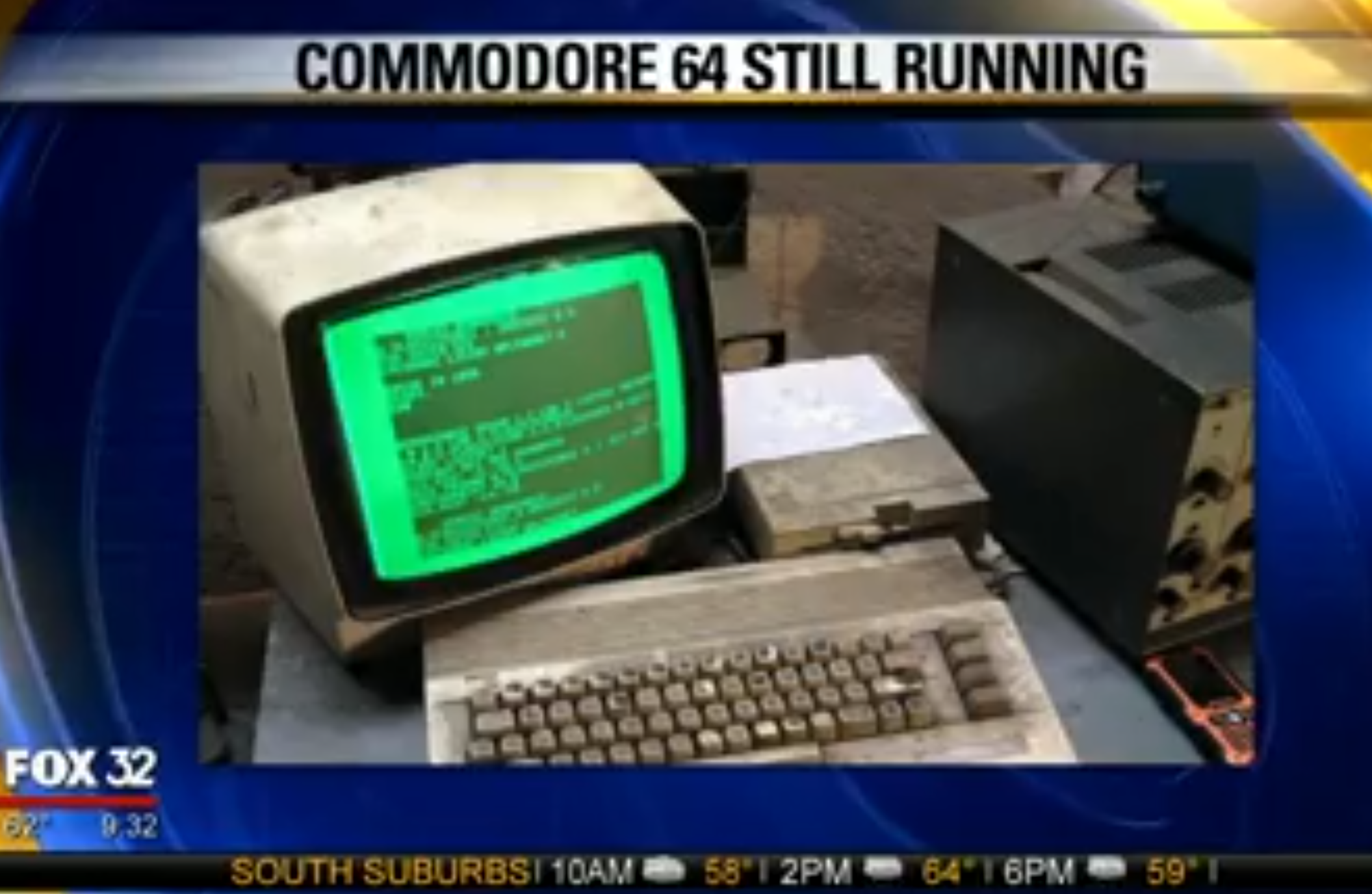Introducing “Stone Tools”
A blog about the productivity software of the 8/16-bit era. No games, just work.
I grew up with computers.
That’s a less-than-revelatory statement for sure, but for a child of the 70s it is a little rare. Growing up in rural Tennessee, no-one I knew owned a home computer, nor did most people really understand why someone would even want one. You already had a typewriter for typing, recipe cards for the kitchen, and board games for fun. If you wanted to play on the TV, buy a Pong machine. What more could a computer contribute to life?
According to a slick Tandy/Radio Shack salesman, we could be organizing family finances, writing the Great American Novel, and educating the children. Computers are inevitable, the next frontier. Don’t be left behind! That sales pitch easily convinced my gadget-loving father to bring home a TRS-80 Model I when I was six or so.
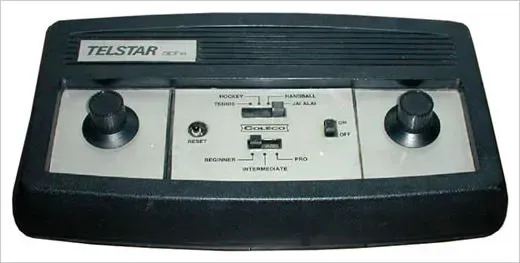
Dad also bought the “Expansion Interface,” a completely separate box big enough to support the monitor, for its increased RAM and floppy drive support. I recall him pointedly explaining that it must be turned on before the CPU, never the other way around, or I would destroy the entire computer. I quickly learned a new emotion that day: utter fascination combined with equal parts terror.
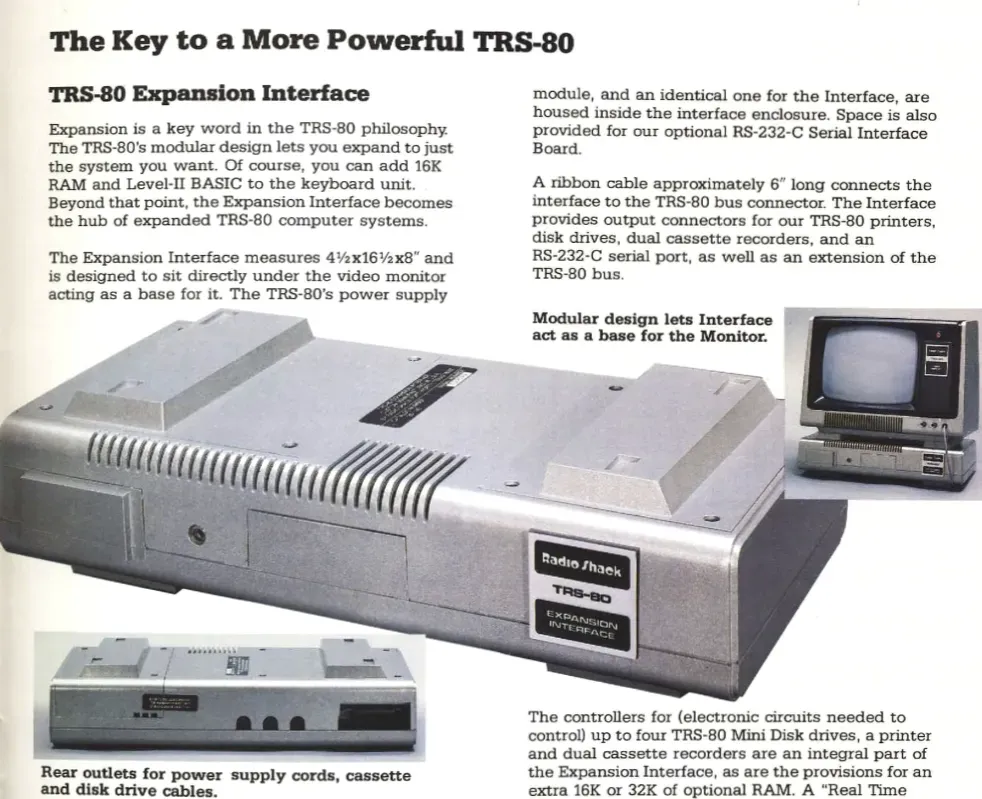
Thankfully, I never did destroy the computer, but I did destroy a lot of ASCII “H” tie-fighters with my “X” x-wing fighter in Star Wars (a non-TM joint). As well, the London flat opening sequence of Scott Adams’s Pirate Adventure has CRT burn-in on my brain. The first game I purchased with my own lawn-mowing money was Zork, in the ziploc baggie, from a clearance bin in the mall; fond memories of betrayal by the cover art versus the actual gameplay.
Games absolutely had a huge impact on the trajectory of my hobbying. That said, it would be a dishonest assessment of my computing history to say, “The Model I introduced me to computer games and I played a lot of games and loved playing games and that’s who I am today: a gamer.”
You know what else made an equally large impact on me? “Biorhythm,” a junk science “calculator” that supposedly determines your physical/emotional/mental high and low points during a month. As a 7-year old, I bought into the concept wholeheartedly, fueled in no small part by the 70s' obsession with horoscopes and the zodiac. Combine mysticism with a computer, and the feeling of unlocking universal secrets was powerfully strong. The computer was calculating! Something! It MUST be true! Just look at that graph!
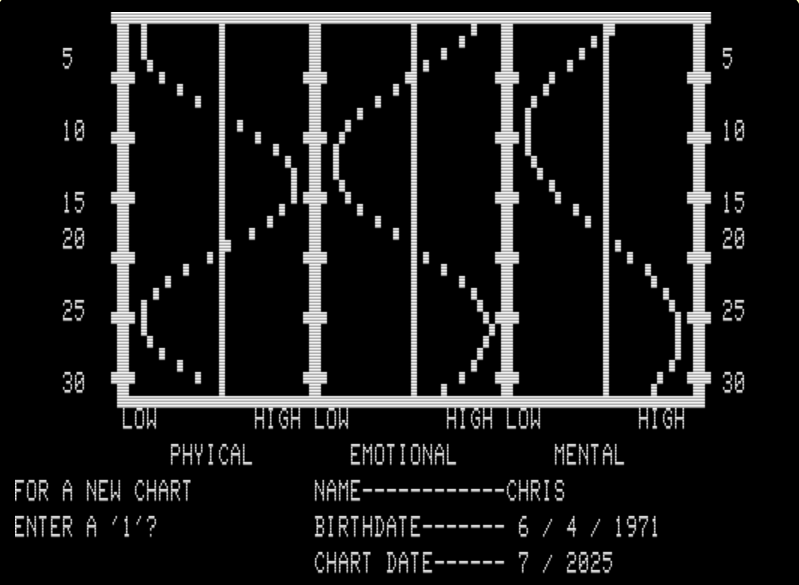
With secret knowledge of the universe unlocked, the computer had already paid for itself as far as I was concerned, especially as I had no firm concept of money at that age. But I knew enough to know money was important to daily life, so I also played around with a “recipe cost” calculator. I didn’t have any real idea of how to work it, but it felt important.
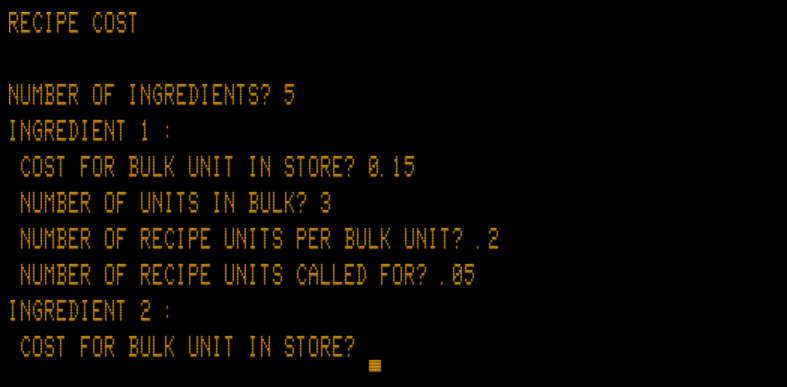
So now we have our finances in order, as well as an understanding of our attenuation to the universe. What else can we do? Well, we all have things we’re thinking so it would be nice to write it all down without needing to go out and buy a new ink-ribbon for the typewriter. We could even share those thoughts without needing carbon paper or a ditto machine. Sounds like a plan.
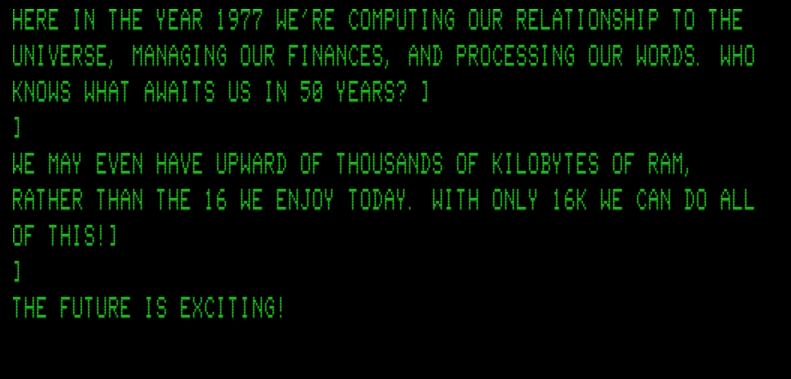
It can be hard for anyone born from the 90s onward to understand how magical it felt to type on a keyboard and see your words appear on a TV/monitor. Coming from Pong, word processing was itself a joyful experience. With that enjoyment came a cultural learning process, as we transitioned away from typewriters. We had to learn the benefits, not just the playful joy.
That took longer than you might expect, especially for those of us who weren’t growing up in Silicon Valley. Even into the 80s in North Carolina, my junior-high typing class was conducted on manual typewriters. Likewise, the zeitgeist understanding of word processors vs. typewriters had cognitive hurdles to jump, as evidenced by the UI of the Coleco ADAM word processor SmartWRITER.
On-screen, a typewriter platen with roller knobs is displayed onto which your letters are typed, reassuring the user, “Don’t worry. It looks strange, but this is functionally equivalent to using a typewriter. Squeeze my hand, you’ll be OK! OK, don’t squeeze THAT hard, you’re just typing not defusing a bomb.” Culturally, we had paradigms to relearn in the transition between “What’s a computer?” and “Everyone has a computer.”
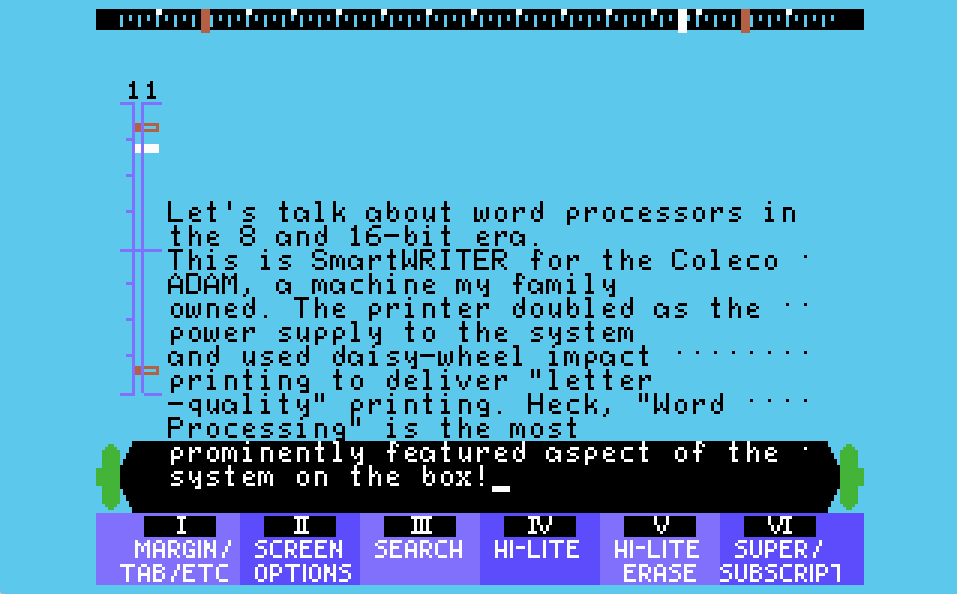
So while I experienced firsthand the leap in graphics fidelity between Pong and ASCII Star Wars, why did I enjoy productivity software so much? What could possibly have fascinated me about “recipe conversions?” I think the answer is pretty simple.
I was empowered.
The computer helped me feel like I could contribute to family life, and even the world, beyond just mowing the lawn and weeding the garden. I could write a bedtime story for my sister. I could organize our recipes. I could read the stars and produce astrological guidance for family and friends. The potential was tangible.
As technology improved, so too did my ability to harness my newfound empowerment. PFS: File on the TRS-80 Model III, Deluxe Paint and Instant Music on the Amiga, Aldus PageMaker and HyperCard on the Mac, and so many more great productivity tools shaped my personal and professional lives.

Of course, I certainly continued to play more than my fair share of games over the decades and they made a huge impact on me. I was utterly blown away when I saw the arcade-perfect Marble Madness on my Amiga at home. But to say I was “impacted by” software can have two very different meanings. Games impacted me similarly to how the movie Raiders of the Lost Ark did. I had a great time, but I wasn’t motivated to start making games or movies, nor did I become an archaeologist.
On the other hand, Deluxe Paint impacted me in a way that changed the course of my life. That introduced me to creating art on the computer, which prompted me to enroll in the art program at UNC-Charlotte, which introduced me to graphic design. That was reinforced by exposure to Aldus PageMaker while working as a journalist on the school newspaper and features magazine.
That’s a completely other kind of impact. I recognize games had just such an impact on some subset of people. The Carmacks and Mechners of the world played games and felt compelled to make games. Still others played and studied games and game history, and continue that obsession into present-day. The gaming side of retro computing is well-chronicled and continues to be covered by many nostalgia-based content creators.
This blog is not about games; it is about the other software.
How work got done in the 8/16-bit computing era
I’m interested in looking holistically at productivity (lets say “non-entertainment”) software, both the contributions and dead-ends to their genres, during the early years of the home computer: 1977 - 1995; basically the length of OMNI Magazine's print run. That was a period of "anything goes" with a lot of developers experimenting with what was possible on a home computer, until Windows95 kind of homogenized the industry (though challengers to the hegemony did pop up from time to time).
I do this research recreationally and for my personal projects as well. It struck me that what fascinates me must surely be of interest to others, and I’d love to share what I learn with the community. Surely I can't be the only one who is getting a little bored of so much retro-gaming discourse? Surely?!
my voice echoes into the TCP/IP void, recedes, and dies

The Matrix
We can understand the intent of this blog as a spreadsheet with machines on the horizontal axis and software genres on the vertical. Any given intersection forms the basis of a potential article in the general form of <software_title> on the <hardware_model>.
Posts take the form of a kind of a review/journal/retrospective. I use every piece of software as I write about it, so you'll get a real-time account of my experience learning and using it productively. You'll get a humanistic assessment of the software, its role in history, and a consideration of its viability today.
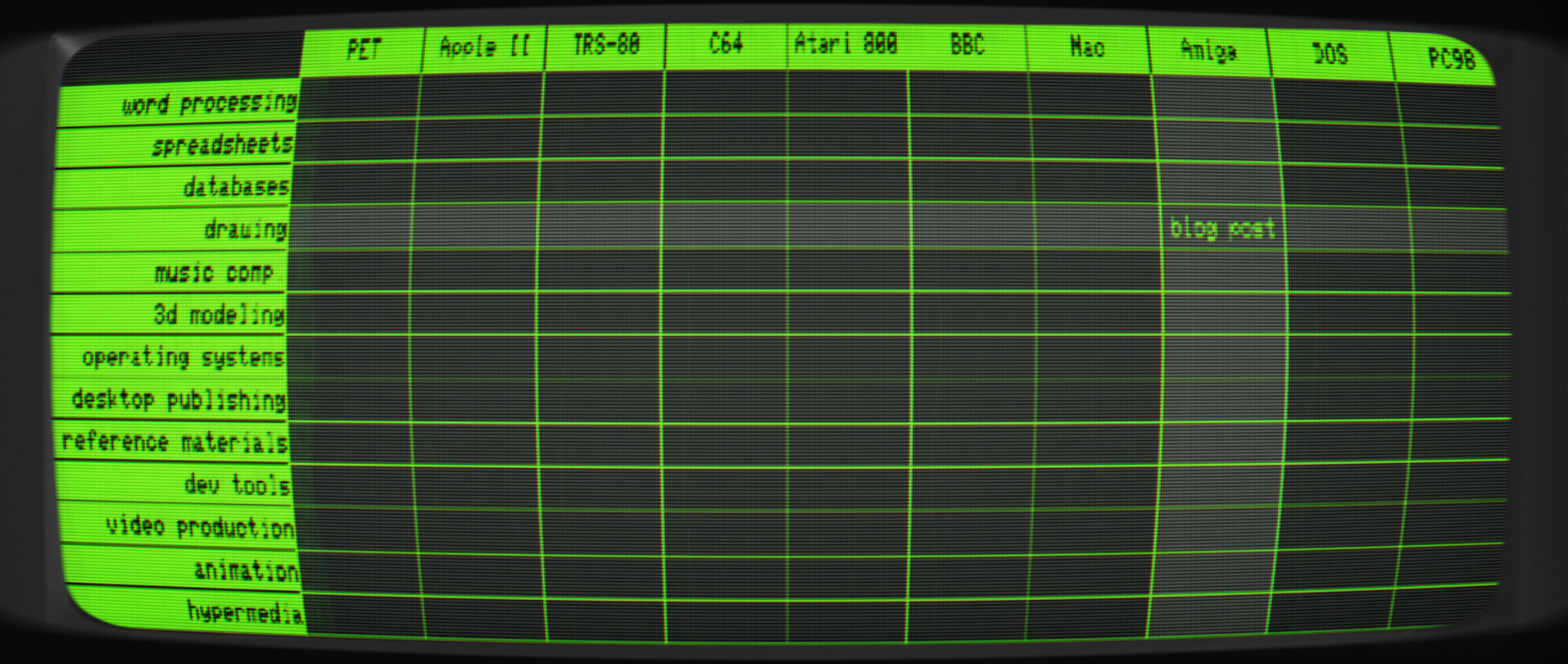
Stone Tools
The title was chosen to reflect that I’m not (necessarily) advocating we all buy Apple IIes and return to the software of the past “when things were better.” Rather, it's a recognition that early productivity tools were the rough-hewn flint axes which got the job done, even as the industry struggled to understand how best to solve the problem of “getting work done.” They were a necessary evolutionary step before the bronze age tools of today. As someone who cloned VisiCalc, I understand just how crude those early tools are.
Even so, I find myself continually re-exploring that old software. There is utility in those old tools and interesting ideas to be mined. Recently I stumbled across something that by all accounts should have set the world on fire, but whose ideas needed more time to germinate before blossoming much later. Discoveries like this are not just nostalgic “what ifs” to opine wistfully upon, they can be dormant seeds of the future.
Computing moves at such an unrelenting pace, those seeds may lie dormant for any number of reasons: bad marketing, released on a dying platform, too expensive, or even too large a mental leap for the public to “get” at the time. I see this blog as a way to explore the history of the work tools we use every day. I don’t do this out of misty-eyed sentimentality, but rather pragmatic curiosity. The past isn’t sacred, but it is still useful.
Perhaps I can sum it up more succinctly like this: stone tools still cut meat.
